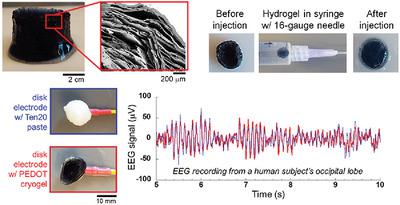当前位置:
X-MOL 学术
›
Macromol. Mater. Eng.
›
论文详情
Our official English website, www.x-mol.net, welcomes your
feedback! (Note: you will need to create a separate account there.)
Cryogel‐Based Electronic–Tissue Interfaces with Soft, Highly Compressible, and Tunable Mechanics
Macromolecular Materials and Engineering ( IF 4.2 ) Pub Date : 2019-10-09 , DOI: 10.1002/mame.201900367 Rosa Ghatee 1 , Anita Tolouei 1 , Jennifer Fijalkowski 1 , Abdulrahman Alsasa 2 , Justin Hayes 1 , Walter Besio 2 , Stephen Kennedy 1, 2
Macromolecular Materials and Engineering ( IF 4.2 ) Pub Date : 2019-10-09 , DOI: 10.1002/mame.201900367 Rosa Ghatee 1 , Anita Tolouei 1 , Jennifer Fijalkowski 1 , Abdulrahman Alsasa 2 , Justin Hayes 1 , Walter Besio 2 , Stephen Kennedy 1, 2
Affiliation

|
Electrically conductive materials with soft, tough, and tunable mechanics have utility in a wide range of applications including neuroprosthetics. Such materials can serve as interfaces between electrical components and tissues, providing mechanical matches with and better conformations to soft, irregularly shaped surfaces. Hydrogels can potentially provide these attributes while remaining hydrated for long periods of time—providing a long‐term and stable electronic–tissue interface. Additionally, in applications that demand implantation, hydrogels can be formulated to locally deliver enhancing therapeutics. Here, hydrogels are developed by entrapping a conducting polymer within a crosslinked poly(acrylic acid) (pAAc) network. Critically, these hydrogels are cast under freezing conditions which produces cryogels that exhibit macroporous, soft, and highly tunable mechanics (0.2–20 kPa, by varying pAAc and crosslinker concentrations). Additionally, these cryogels are tough enough to survive over 90% compression, which enables survival after being passed through 16‐gauge needles. Cryogels also exhibit electrical conductivities that are sufficient to record alpha waves from the scalp of human subjects. Growth of fibroblasts cultures in the presence of these cryogels produce statistically similar viabilities compared to controls and do not disrupt fibroblast cell cycles. Finally, cryogels are capable of being loaded with and delivering proteins that can potentially combat inflammation.
中文翻译:

基于Cryogel的电子-组织接口,具有柔软,高度可压缩和可调的力学特性
具有柔软,坚韧和可调力学的导电材料可在包括神经假体在内的广泛应用中使用。这样的材料可以用作电子组件和组织之间的界面,从而为柔软,不规则形状的表面提供机械匹配并更好地构形。水凝胶可以在长时间保持水合状态的同时提供这些属性,从而提供长期稳定的电子-组织界面。另外,在需要植入的应用中,可以配制水凝胶以局部递送增强的治疗剂。在此,通过将导电聚合物截留在交联的聚丙烯酸(pAAc)网络中来开发水凝胶。至关重要的是,这些水凝胶是在冰冻条件下浇铸的,产生的冰凝胶具有大孔,柔软,以及高度可调的力学特性(通过改变pAAc和交联剂浓度达到0.2–20 kPa)。此外,这些冰晶玻璃坚韧到足以承受90%以上的压缩,从而在通过16号针头后仍能生存。冰晶石还表现出足以记录人类受试者头皮发出的阿尔法波的电导率。与对照相比,在存在这些冷冻凝胶的情况下成纤维细胞培养物的生长产生统计学上相似的生存力,并且不会破坏成纤维细胞的细胞周期。最后,冷冻凝胶能够装载并传递可能对抗炎症的蛋白质。通过16号针头后可以存活。冰晶石还表现出足以记录人类受试者头皮发出的阿尔法波的电导率。与对照相比,在存在这些冷冻凝胶的情况下成纤维细胞培养物的生长产生统计学上相似的生存力,并且不会破坏成纤维细胞的细胞周期。最后,冷冻凝胶能够装载并传递可能对抗炎症的蛋白质。通过16号针头后可以存活。冰晶石还表现出足以记录人类受试者头皮发出的阿尔法波的电导率。与对照相比,在存在这些冷冻凝胶的情况下成纤维细胞培养物的生长产生统计学上相似的生存力,并且不会破坏成纤维细胞的细胞周期。最后,冷冻凝胶能够装载并传递可能对抗炎症的蛋白质。
更新日期:2019-12-05
中文翻译:

基于Cryogel的电子-组织接口,具有柔软,高度可压缩和可调的力学特性
具有柔软,坚韧和可调力学的导电材料可在包括神经假体在内的广泛应用中使用。这样的材料可以用作电子组件和组织之间的界面,从而为柔软,不规则形状的表面提供机械匹配并更好地构形。水凝胶可以在长时间保持水合状态的同时提供这些属性,从而提供长期稳定的电子-组织界面。另外,在需要植入的应用中,可以配制水凝胶以局部递送增强的治疗剂。在此,通过将导电聚合物截留在交联的聚丙烯酸(pAAc)网络中来开发水凝胶。至关重要的是,这些水凝胶是在冰冻条件下浇铸的,产生的冰凝胶具有大孔,柔软,以及高度可调的力学特性(通过改变pAAc和交联剂浓度达到0.2–20 kPa)。此外,这些冰晶玻璃坚韧到足以承受90%以上的压缩,从而在通过16号针头后仍能生存。冰晶石还表现出足以记录人类受试者头皮发出的阿尔法波的电导率。与对照相比,在存在这些冷冻凝胶的情况下成纤维细胞培养物的生长产生统计学上相似的生存力,并且不会破坏成纤维细胞的细胞周期。最后,冷冻凝胶能够装载并传递可能对抗炎症的蛋白质。通过16号针头后可以存活。冰晶石还表现出足以记录人类受试者头皮发出的阿尔法波的电导率。与对照相比,在存在这些冷冻凝胶的情况下成纤维细胞培养物的生长产生统计学上相似的生存力,并且不会破坏成纤维细胞的细胞周期。最后,冷冻凝胶能够装载并传递可能对抗炎症的蛋白质。通过16号针头后可以存活。冰晶石还表现出足以记录人类受试者头皮发出的阿尔法波的电导率。与对照相比,在存在这些冷冻凝胶的情况下成纤维细胞培养物的生长产生统计学上相似的生存力,并且不会破坏成纤维细胞的细胞周期。最后,冷冻凝胶能够装载并传递可能对抗炎症的蛋白质。











































 京公网安备 11010802027423号
京公网安备 11010802027423号